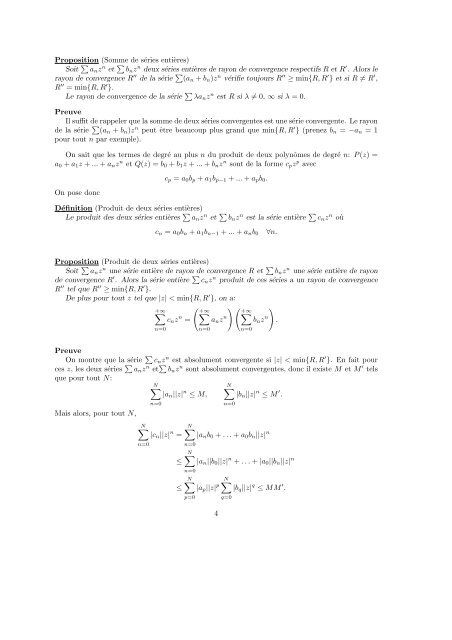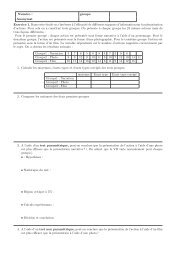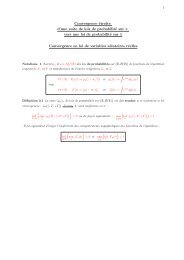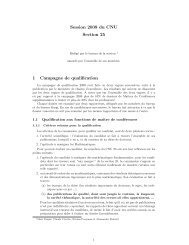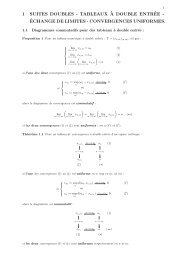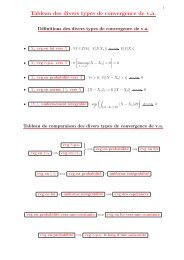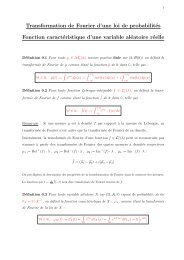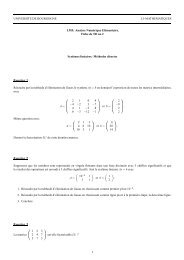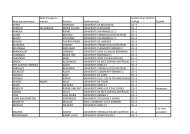Séries enti`eres, fonctions holomorphes - Institut de mathématiques ...
Séries enti`eres, fonctions holomorphes - Institut de mathématiques ...
Séries enti`eres, fonctions holomorphes - Institut de mathématiques ...
- No tags were found...
Create successful ePaper yourself
Turn your PDF publications into a flip-book with our unique Google optimized e-Paper software.
Proposition (Somme <strong>de</strong> séries entières)Soit ∑ a n z n et ∑ b n z n <strong>de</strong>ux séries entières <strong>de</strong> rayon <strong>de</strong> convergence respectifs R et R ′ . Alors lerayon <strong>de</strong> convergence R ′′ <strong>de</strong> la série ∑ (a n + b n )z n vérifie toujours R ′′ ≥ min{R, R ′ } et si R ≠ R ′ ,R ′′ = min{R, R ′ }.Le rayon <strong>de</strong> convergence <strong>de</strong> la série ∑ λa n z n est R si λ ≠ 0, ∞ si λ = 0.PreuveIl suffit <strong>de</strong> rappeler que la somme <strong>de</strong> <strong>de</strong>ux séries convergentes est une série convergente. Le rayon<strong>de</strong> la série ∑ (a n + b n )z n peut être beaucoup plus grand que min{R, R ′ } (prenez b n = −a n = 1pour tout n par exemple).On sait que les termes <strong>de</strong> <strong>de</strong>gré au plus n du produit <strong>de</strong> <strong>de</strong>ux polynômes <strong>de</strong> <strong>de</strong>gré n: P (z) =a 0 + a 1 z + ... + a n z n et Q(z) = b 0 + b 1 z + ... + b n z n sont <strong>de</strong> la forme c p z p avecOn pose doncc p = a 0 b p + a 1 b p−1 + ... + a p b 0 .Définition (Produit <strong>de</strong> <strong>de</strong>ux séries entières)Le produit <strong>de</strong>s <strong>de</strong>ux séries entières ∑ a n z n et ∑ b n z n est la série entière ∑ c n z n oùc n = a 0 b n + a 1 b n−1 + ... + a n b 0∀n.Proposition (Produit <strong>de</strong> <strong>de</strong>ux séries entières)Soit ∑ a n z n une série entière <strong>de</strong> rayon <strong>de</strong> convergence R et ∑ b n z n une série entière <strong>de</strong> rayon<strong>de</strong> convergence R ′ . Alors la série entière ∑ c n z n produit <strong>de</strong> ces séries a un rayon <strong>de</strong> convergenceR ′′ tel que R ′′ ≥ min{R, R ′ }.De plus pour tout z tel que |z| < min{R, R ′ }, on a:(+∞∑+∞) (∑+∞)∑c n z n = a n z n b n z n .n=0n=0n=0PreuveOn montre que la série ∑ c n z n est absolument convergente si |z| < min{R, R ′ }. En fait pources z, les <strong>de</strong>ux séries ∑ a n z n et ∑ b n z n sont absolument convergentes, donc il existe M et M ′ telsque pour tout N:N∑N∑|a n ||z| n ≤ M, |b n ||z| n ≤ M ′ .Mais alors, pour tout N,n=0N∑|c n ||z| n =n=0≤≤n=0N∑|a n b 0 + . . . + a 0 b n ||z| nn=0N∑|a n ||b 0 ||z| n + . . . + |a 0 ||b n ||z| nn=0N∑ ∑N|a p ||z| p |b q ||z| q ≤ MM ′ .p=04q=0


